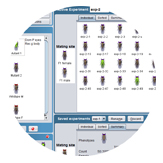
 Dr. Jeremy Orloff and Dr. Jonathan Bloom
Dr. Jeremy Orloff and Dr. Jonathan Bloom
Title: Flipping the Dice: An active-learning, technology-enhanced, up-to-date 18.05 (Introduction to Probability and Statistics)
Seminar Date & Time: Monday, April 7, 2014 @ 1:30 pm
View the slides from Dr. Orloff and Dr. Bloom’s Seminar
Watch Dr. Orloff’s and Dr. Bloom’s Seminar
Dr. Jeremy Orloff is an instructor in the Math Department and Experimental Study Group at MIT. Dr. Jonathan Bloom is a Moore Instructor and NSF Post-doctoral fellow in the Mathematics Department at MIT where he does research on low-dimensional topology and geometry. Together with Professor Haynes Miller, Dr. Orloff and Dr. Bloom have been working to bring flipped, active-learning classes to the Math Department.
In their seminar, titled Flipping the Dice: An Active-learning, tech-enhanced, up-to-date 18.05 (Introduction to Probability and Statistics), Drs. Orloff and Bloom discussed how they dramatically transformed the Introduction to Probability and Statistics course (MIT course 18.05) and, by doing so, revived the class from one with dropping enrollment and low student engagement.
Their work, supported by a Davis Foundation Grant awarded to Professor Haynes Miller, was primarily focused on incorporating new, active-learning approaches into MIT course 18.05 (Introduction to Probability and Statistics). Prior to the transformation, MIT course 18.05 was a traditional lecture course for non-math majors that suffered from dwindling enrollment. To transform the course, Drs. Bloom and Orloff decided to transform all components of the course, including the curriculum, pedagogy, classroom space and technology all at the same time. While the curriculum transformation was not a focus of their talk, they did mention that they transformed the curriculum to incorporate a new section on Bayesian methods into the course. In addition, Drs. Bloom and Orloff wrote a new online text resource for the course specifically tailored to the concepts covered in MIT Course 18.05 as no published textbook met their needs.
The newly-transformed, active-learning version of MIT course 18.05 launched for the first time in spring 2013 and again in spring 2014. The course meets 3 times a week for 80 minutes each in a TEAL (Technology-Enhanced Active Learning) Classroom at MIT. Prior to class, students must do pre-class reading and answer a few reading questions on the 18.05 MITx course website. The reading questions are designed primarily to ensure that students prepare prior to class and students can check whether their answers are correct right away. During the class time itself, Drs. Bloom and Orloff do very little lecturing and instead integrate several group problem-solving sessions that take place at boards around the room, whole-class and small group discussions, and clicker questions into each class session. One day a week, students have the opportunity to perform more advanced computer-based studio simulations using R, a free, open-source, cross-platform computer simulation program for statistics. In addition, the students still complete traditional problem sets, but Drs. Orloff and Bloom developed a problem set checker on the MITx course website in which students can simply check whether their answer is correct prior to turning in their handwritten answers.
While transforming the course was time- and labor-intensive, the benefits are overwhelming. Preliminary evidence demonstrates that Drs. Bloom and Orloff can cover more material with greater understanding. Drs. Bloom and Orloff have found that the students are much more engaged, have obtained the opportunity to get to know their instructors well, and that the well planned TEAL classroom space is so instrumental to their course’s success. In addition, Drs. Orloff and Bloom are also working with Dr. Glenda Stump in MIT’s Teaching and Learning Laboratory to perform a full assessment, including a statistics concept survey, student feedback surveys, MITx analysis, and student interview data, of the effectiveness of the transformation. The success of the transformed Introduction to Probability and Statistics serves as an example by which many instructors can transform their own courses into active-learning, technology-enhanced, modern courses!



